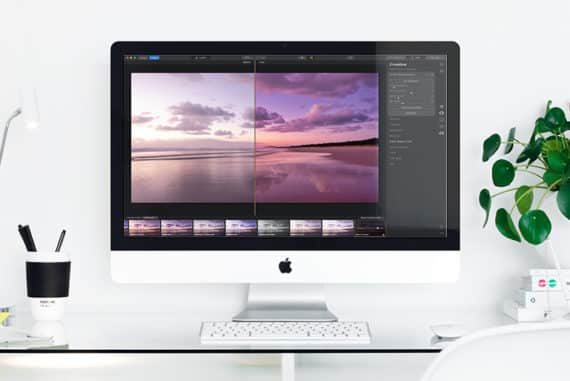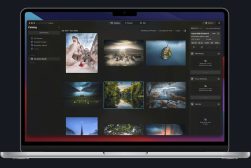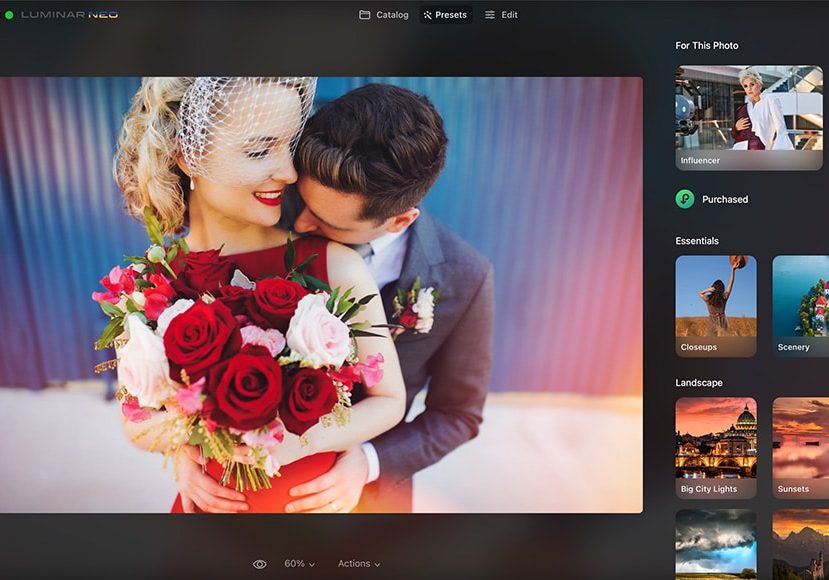
Luminar Neo Review (My Latest Test Results)
A comprehensive review of the strengths and weaknesses of Luminar Neo photo editing software with the latest test results on the September updates.
Luminar | Software | Software Reviews | By Mark Condon | Last Updated: October 27, 2023
I’ve been updating this Luminar Neo review for over a year to thoroughly test Skylum’s award-winning photo editing software.
Luminar Neo is a powerful AI image editor for Mac and Windows that can be bought outright or as part of a subscription plan.
It’s an ideal tool for both novice and experienced picture editors or those who simply want to play around with fun photo effects.
Luminar Neo’s key benefit is its ability to make complex edits simple and fast for any level of user.
By harnessing the power of AI, users can replace skies, enhance portraits and remove backgrounds, often with just one mouse click.
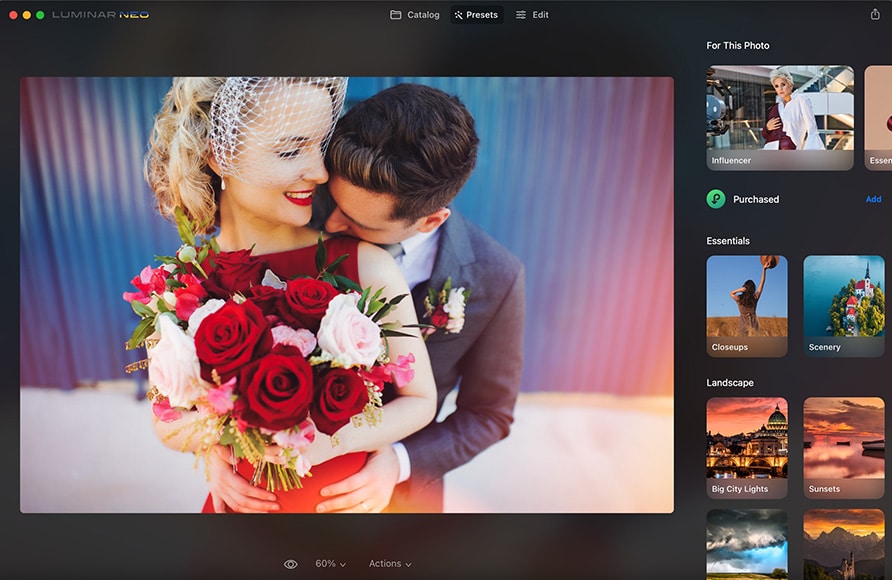
Powerful AI editing tools improve photos in less time. Affordable one-time price and expandable features.
In comparison to Adobe Lightroom, Luminar Neo offers a vast array of image editing tools and organizational features at a more affordable price point.
Thanks to recent updates, various Luminar Extensions bring additional editing powers to the core software, broadening its appeal to photographers and designers.
For this Luminar Neo review, I’ve been testing the latest version (v1.15.0) with a selection of RAW and JPEG images.
So, let’s take a closer look together at whether you should buy Luminar Neo in 2023.
Table of Contents
What is Luminar Neo?
Luminar Neo is a powerful image editor for Mac and Windows, powered by AI technologies that can simplify complex photo editing tasks, making them fast and fun.
Headline AI features include the ‘god-like’ ability to relight a scene, replace the sky, remove powerlines and dust spots, and perform various jaw-dropping portrait enhancements in just a couple of mouse clicks.
The main attraction of Luminar Neo is the opportunity for a complete novice to carry out immensely complex photo editing tasks with a couple of clicks. It’s also useful for more experienced photographers who want to save time or experiment with their image editing.
In addition to this artificial intelligence wizardry, Luminar Neo provides a solid selection of core editing tools that rival other popular image editors.
Numerous Presets are supplied (with more available to download/buy), which apply instant photo effects to images to alter their look – AI recognises the image and suggests suitable ‘For This Photo’ Presets to save time.

The ability to buy Neo as a one-off purchase is particularly attractive.
Luminar Neo pairs up with Luminar Share, a basic mobile app for iPhone and Android devices that allows you to wirelessly transfer your smartphone images to be edited in the desktop Neo software or vice versa to be shared on your favourite social media network.
You can also install Neo as a plugin for Photoshop and a plugin for Lightroom Classic, allowing it to load from within their respective interfaces.
This is handy if you want to keep using the DAM functionalities of your existing LRC catalogue while taking advantage of the AI tools in Neo, for example.
Pros & Cons of Luminar Neo for Photo Editing
- Affordable one-time price
- Easy and fun to use
- Effective one-click presets
- Impressive AI tools
- Excellent portrait enhancers
- Fast RAW image imports
- Promising layer-based workflow
- Handy extensions help with specific tasks
- Especially useful as a Lightroom Plugin
- Slow to respond (initially)
- Limited photo management features
- Limited print and export options
- Disappointing mobile app
- No GPU acceleration (except Extensions)
- No free trial or student saving
What’s New in the Updated Luminar Neo?
Skylum released Luminar Neo in February 2022 with the intention of providing frequent updates.
This Luminar Neo review is based on the latest version, v1.14.1, which was released on October 12, 2023.
This update includes the brand-new Neon & Glow feature, Tilt Shift and more.
The previous update included the Studio Light portrait feature for replicating lighting effects, a Blur Tool for various creative effects and a variety of bug fixes.
Other updates have also seen various additions to the core photo editing software, including the addition of a histogram, dodge and burn tool, clone tool, and portrait background removal AI.
Also, Skylum added a new Undo and Redo functionality, performance improvements in the RAW Develop and Mask AI tools
Luminar Neo is now built on a new ‘modular’ framework, which means that larger feature updates can be slotted into the core feature set more easily and regularly than before.
A recent example is the release of several ‘Extensions’ that build upon the core editing software with useful tools.
In releasing these Extensions, Skylum has said that they’re fulfilling the main vision for Luminar Neo to become a one-stop creative platform for photographers.
We’ll take a closer look at the Extensions later in the review.
1. Skylum Luminar Neo Installation & Set Up
After downloading and launching the Luminar Neo installer, you’re given the option to install Neo as a plugin for Photoshop and Lightroom Classic (if you’re already an Adobe photo editing software subscriber).
Strangely enough, you’re no longer able to install third-party plugins in Luminar Neo (such as Topaz Gigapixel for enlargements) – something you were able to do with Luminar AI. Hopefully, we’ll see this in a future update.
The program takes up 2.84GB of space on my Mac’s hard drive, which seems average when compared to other photo editors.
When the installation is complete and you’ve created a Skylum account, you’re shown a QR code that installs the companion mobile app Luminar Share.
We’ll take a closer look at the app later, but don’t hold your breath – it doesn’t do much!
2. Importing & Browsing Images
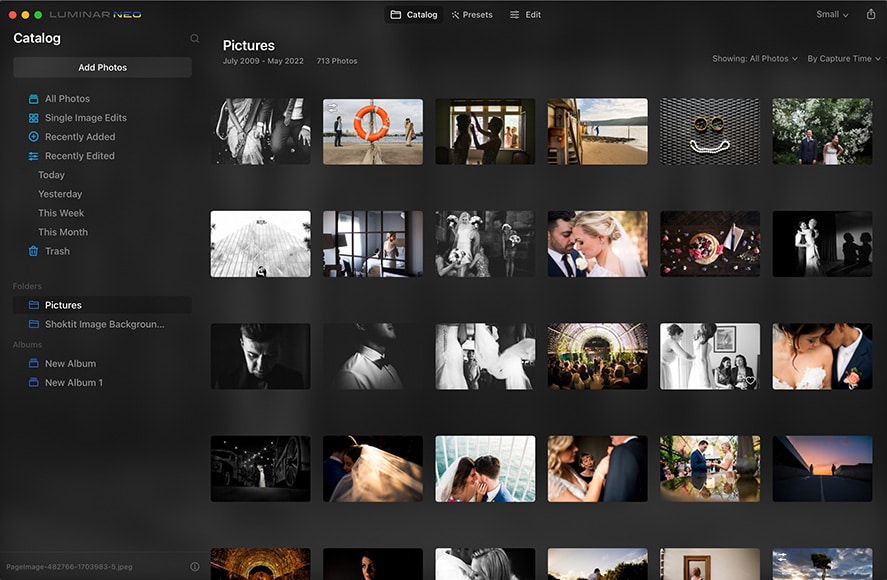
Getting images into Neo is simple and fast.
Getting photos into Luminar Neo is dead simple and a refreshing experience for anyone who’s ever tried using Lightroom for the first time.
Clicking the Add Photos button does exactly that – you choose a folder or selection of photos on your hard drive, click Add, and then everything suddenly appears in your Luminar catalogue.
Photos are added impressively quickly on my 2021 MacBook M1 (32GB RAM) – testing on my wife’s 2020 Macboom Air with 16GB of RAM was also similarly fast.
It’s important to note that photos aren’t really ‘imported’ into Luminar Neo – they are actually being ‘referenced’ in their original location, much like a file browser. This has certain distinct advantages and disadvantages.
The main caveat to this file browser experience is that the photos need to exist somewhere outside Neo, or they appear as ‘missing’.
This means that you’re unable to import images to Neo from your camera’s memory card unless: a) you’re willing to keep the card in the card reader until you’re finished with the images, or b) you transfer the images to your hard drive first, then add the photos to Neo from that new location.
Confused? Basically, when your photos are moved or deleted on your hard drive (external to Luminar Neo), the same thing happens within Neo.
If, however, you delete an image from within Luminar Neo, it’s added to a ‘Luminar Trash’, with the original image remaining intact outside of Neo.
Software such as Lightroom, however, employs an actual image-importing process which creates a duplicate version of the file within a separate catalogue, meaning any external changes won’t affect the catalogued image.
For many photographers, Luminar Neo’s file browser approach to file management will be a breath of fresh air – there’s close to zero wait time for photos to appear in the software, ready to be edited.
However, for professional photographers who need a direct way to get images off their SD card into editing software, Luminar Neo isn’t an appropriate choice.
It’s also worth noting that you can add photos from external hard drives or even network-attached storage (NAS), but as soon as you detach the devices, Neo will no longer be able to show them.
3. Photo Organisation in Luminar Neo

Organisation options auto-populate depending on your actions.
Ignoring the restrictions on importing from non-permanent devices/locations, you have to admire the simplicity of photo management in Luminar Neo.
On the left of the screen, the ‘Catalog’ module consists of 5 locations that auto-update based on your actions:
- All Photos
- Single Image Edits
- Recently Added
- Recently Edited
- Trash
Hovering over each title reveals the number of images in each case, and ‘Recently Added’ and ‘Recently Edited’ offer drop downs that reveal the dates the actions were performed.
Under this, the ‘Folders’ level houses any folder from your hard drive that you add to Luminar Neo.
Finally, there are the ‘Albums’, which behave similarly to Lightroom Collections, allowing you to compile collections of various images that already exist in your Neo catalogue.
You can add multiple photos to an album or create a new one by selecting them all and right-clicking to reveal the options. Oddly, you can’t drag and drop the photos into the Albums panel to create new albums.
4. Catalog Interface

Right-clicking on photos reveals various options.
Luminar Neo Catalog’s single photo view shows a filmstrip below – right-clicking photos in the single view or within the film strip reveals various options:
- Set Flag
- Adjustments
- Export
- Share
- Open In
- Go To
- Create Album
- Move to Luminar Trash
- Show in Finder
Aside from the self-explanatory, ‘Set Flag’ allows you to Favourite, Reject or Unmark, using the same shortcut keys as Lightroom, and ‘Adjustments’ allow you to Sync, Copy or Paste any image edits made across other photos.
‘Open In’ allows you to open the photo in various apps you may already own: Photoshop, Lightroom, Photos, Elements and Aurora HDR.
There’s also a heart icon to favourite, an ‘X’ to reject and an eye icon that shows a before (unedited) version of your image, although I still prefer the implementation of the Before/After tool in Luminar AI.
One slight annoyance is the frustratingly narrow side scroll bar, which only comes into partial view when you move your mouse’s scroll wheel.
5. Luminar Presets Interface

The software intelligently recognises the photo containing a girl’s face and recommends portrait presets to suit.
Next to the ‘Catalog’ module is ‘Presets‘ – clicking this reveals a selection of thumbnails with somewhat ambiguous titles, like ‘Experimental’ and ‘Influencer’.
These presets were the headline feature of Luminar AI (named ‘Templates’), promising to save hours of fiddling around with sliders to achieve the desired look.
The ‘For This Photo’ presets are your first taste of artificial intelligence coming to your rescue in Luminar Neo, predicting the one-click ‘look’ that would best complement your photo, based on its perceived contents.
In practice, if your photo contains a person, ‘For This Photo’ will show presets best suited for portrait photography. If the photo is of a landscape, the AI suggestion will show presets such as ‘Scenery’, ‘Sunsets’ or ‘Easy Landscapes.’
Clicking into each main preset category reveals various more associated presets, and so begins the testing process.

Clicking a preset title reveals other associated presets.
Rather than complicating the process of photo editing, the Luminar Neo Presets panel seems to have been designed to encourage experimentation – ‘Influencer’, ‘Cozy Den’ and ‘Winter Refuge’ mean nothing until they’re clicked.
Don’t like the effect? Simply click the arrow to return to the original, or click the heart icon to add it to your favourite presets.
Bizarrely, there’s no option to fine-tune the presets in Luminar Neo like there was in Luminar AI – you either apply the preset in its entirety…. or you don’t.
Being able to ‘back off’ the effects of a preset would be a welcome feature, so hopefully, we see this added to Neo in a future update.
6. Luminar Neo Edit Interface
The ‘Edit’ module houses all the manual and automated editing tools of Luminar Neo. In its ‘Tools’ panel, you’ve got the following:
- Crop AI
Essentials
- Develop
- Enhance AI
- Erase
- Structure AI
- Color
- Black & White
- Details
- Denoise
- Landscape
- Vignette
Creative
- Relight AI
- Sky AI (Sky replacement)
- Atmosphere AI
- Sunrays
- Dramatic
- Mood
- Tonight
- Matte
- Mystical
- Glow
- Film Grain
- Blur (NEW)
Portrait
- Portrait Bokeh AI tool
- Face AI
- Skin AI
- Body AI
- High Key
- Studio Light (NEW)
Professional
- Supercontrast
- Color Harmony
When clicked, each of the tools reveals multiple sliders and sub-menus.
Anything with a slider invites you to experiment, with the partially hidden sub-menus containing options for when you’re more comfortable with the basic functionality of each tool.
Those coming from more professional-photographer-orientated photo editing software may poopoo the somewhat hodgepodge organisation of the tools, but if you’re new to photo editing, the layout is user-friendly and quickly becomes familiar,
Anything with ‘AI’ after its name denotes something with a very special party trick – more on those later.
Next to ‘Tools’ is the ‘Edits’ panel, which is kind of like Lightroom’s History tool, keeping track of each edit you’ve made to the image.
You’re also presented with another eye icon for a before/after, a revert arrow to undo each specific edit, and a pen icon, which allows you to make local adjustments like creating masks to add/remove effects.
One thing I found rather confusing was the fact that any preset you apply to your image will be shown in the ‘Edits’ panel, broken up as individual steps of the edit.
e.g. the ‘Nighthawks’ black and white Preset applies ‘Black & White’, ‘Details’, ‘Enhance AI’, ‘Structure AI’, ‘Face AI’, ‘Denoise and Develop’ – I assume this may change slightly depending on the contents of the photo.

Presets can be viewed in the Edits panel as individual edits.
While this allows for some granular control over the preset, it’s difficult to tell what differences the individual edits actually made to your image – choosing to control each one feels like a stab in the dark.
Layers
You’ll also find ‘Layers’ on the left of the ‘Edit’ module – clicking the + icon reveals a selection of overlays that you can add to your image to produce various effects: ‘Flares’, ‘Light Leaks’, ‘Sparklers’ and ‘Stardust Bokeh’.
You can also load any image from your hard drive to use as a layer for a double exposure effect. Any layer’s opacity and blending mode can be altered to achieve your desired look.
Those hoping for a true layer-based editing experience akin to Photoshop or ON1 Photo RAW will be disappointed, but if all you want is a simple way to experiment with your photos, Neo comes up with the goods.


As you can see in the before/after above, I was able to add a cool flare/light leak effect to an image from a recent wedding I shot using the new Layers feature and the results look great.
(I also applied one of the Presets that Luminar Neo recommended – all up, the entire edit took less than a minute.)
7. Standard Editing Tools for RAW files & JPEGs

Clicking tools reveal various options for full manual control over editing.
For photographers who like to take a manual approach to their photo editing, the Develop panel is where it all starts – ‘Exposure’, ‘Highlights’ and ‘Shadows’ are familiar, while ‘Smart Contrast’ is unique to Luminar, controlling both highlights and shadows in tandem to give your image a nice boost.
Under that, ‘Blacks & Whites’, ‘Curves’, ‘Sharpness’, ‘Noise Reduction’ and ‘Transform’ are self-explanatory, while ‘Color’ refers to temperature and white balance, and ‘Optics’ fixes lens distortion and vignetting.
(According to a Skylum rep who talked to PCMag, Luminar Neo includes a database of lens and camera profiles that are used behind the scenes for these various optical corrections. For anything that doesn’t exist in the database, it uses general algorithms.)
Under the ‘Develop’ panel, there’s a mixture of AI-powered tools and more familiar standard ones such as ‘Vignette’ and ‘Details’.
Confusingly, ‘Color’ exists here too but deals with ‘Saturation’, ‘Vibrance’ and the removal of colour casts.
Also of note is the ‘Landscape’ tool, which allows you to dehaze a photo, add the illusion of a photo taken at golden hour and even enhance the foliage in a scene.
The explanatory labelling of tools is Skylum attempt to make the photo editing process more accessible to the average person. While in Lightroom, you’d need to twiddle with colour temperature, clarity and various other tools to get a golden hour effect, in Luminar Neo, you can get the same result in a single click.
The ‘Creative’ panel houses tools that you really need to experiment with to understand their effect, despite explanatory names such as ‘Dramatic’, ‘Mood’ and ‘Mystical’.
My favourite is the ‘Sunrays’ tool, which still blows my mind despite being several years old. The ability to place a realistic sun in your image, and have the sun’s rays wrap around or poke through objects as if the entire scene were three-dimensional is simply incredible.



Various options finetune the look of the sun’s rays.
The ‘after’ image above is just from applying the default sunrays settings – from here, you can use various other sliders to fine-tune the look to your preference – see the screenshot above which shows the options.
The ‘Portrait’ panel contains mostly AI tools, and finally, the ‘Professional’ panel, which houses ‘Supercontrast’ and ‘Color Harmony’.
‘Supercontrast’ allows you to adjust the highlights, mid-tones and shadows contrast individually, then use balance sliders to fine-tune the adjustment.
‘Color Harmony’ deals with ‘Brilliance’ and ‘Warmth’, which seem similar to ‘Saturation’ and ‘Color Temperature’ found elsewhere in the panel.
Under this, you’ve got ‘Color Contrast’, ‘Split Color Warmth’ and ‘Color Balance’, which allows you to separately adjust the colours in the shadows, mid-tones or highlights.
Tilt Shift Blur (Released Sep 26, 2023)
This recent update to the Blur Tool lets you transform life-sized locations or subjects into miniature-scale models.
Just like with the other types of blur, you can adjust the amount, angle, and position of the effect and use masking to selectively apply it.
8. Luminar Neo’s AI Tools

Realistic portrait manipulation is well within the grasp of anyone. Image: Maria Lysenko
OK, so this is where all the fun starts.
If you’ve read any other Lumnar Neo review, you’ve no doubt already been bombarded by images of skies being replaced and faces slimmed – it’s easy to become desensitized by just how incredibly simple and realistic complex photo manipulation has become.
In a nutshell, Luminar Neo offers a suite of non-destructive RAW editing tools powered by artificial intelligence that lets you carry out complex editing tasks in just a couple of clicks.
While several of Luminar Neo’s much-touted AI editing tools are actually available in some form or another in Photoshop and elsewhere, the way they’re presented in Neo is much more user-friendly.
Here’s the current selection of AI tools:
- Mask AI
- Portrait Background Remover AI (New!)
- Crop AI
- Enhance AI
- Structure AI
- Relight AI
- Sky AI
- Atmosphere AI
- Portrait Bokeh AI
- Face AI
- Skin AI
- Body AI
I’ve tested all the available tools and can confirm that they work exceptionally well in the majority of cases.
As a professional photographer with over 10 years of experience editing photos, I have little need for certain AI tools offered by Luminar Neo.
I can achieve similar results to ‘Crop AI’, ‘Enhance AI’ and ‘Structure AI’ manually by using tools found in the standard adjustment panels, although sliding the Enhance tool is oddly addictive and fun.
Things like adding realistic bokeh to an image, removing a background (with the updated background removal tool) or relighting a scene (controlling foreground and background brightness), I can definitely handle, but it takes considerable time to do properly.
However, I draw the line at replacing an entire sky, changing the shape of a subject’s body or performing delicate facial retouching. This is the realm of a professional retoucher with years of experience.
With Luminar Neo, you can achieve all the above in a couple of clicks – sometimes, with just one click, like in the example of the Eiffel Tower below.
I could show you before and after images of the effects of these AI tools, but to be honest, they’re all best illustrated right here on the Luminar homepage – you can even click and interact with some of the tools in real-time.
Sky Replacement AI
Out of all the AI-powered tools, Sky AI (aka the sky replacement tool) is still my favourite and most impressive.
Whether your photo is a pure landscape or an urban scene with people and buildings, Neo does a jaw-dropping job of swapping out the sky and relighting the scene to suit.
For those who remember, Luminar original headline feature was sky replacement, although recently, most other premium image editing apps also offer something similar.



100% zoom highlights the delicate masking of the new sky through the tower.
Even if your original photo is a cloudless scene at midday, with sky replacement, you can make it look like a sunset shot in a couple of seconds.
You can see in the screenshot above the incredible level of detail retained by the Sky Replacement (Sky AI) tool – every gap in the Eiffel Tower shows the replacement sky through it!
Cloning and masking something like this in Photoshop would take hours and a very skilled hand.
Face, Skin, Body AI
I’m also impressed with the Portrait enhancement tools, which can perform edits to faces and bodies that could rival even the best professional retouchers.
I can see the portrait manipulating features being useful for quickly editing selfies to be shared on social media – things like whitening teeth, smoothing skin or even changing eye colour can be done in a couple of seconds with Luminar Neo.
Aside from the ability to slim faces, darken lips and whiten teeth with Face AI, by far the most useful application, in my opinion, is the ability to control the face light even in photos of multiple people – this is incredibly helpful for me when editing family groups, with the software controlling the brightness of each face in the photo.


You can see in the ‘After’ image above how the software uses artificial intelligence to recognise each of the subjects’ faces for me to manually add the Face Light feature with the slider.
(If you look closely, you’ll notice the second girl’s face is unaffected by the tool, presumably because the Face Light tool has brought the exposure up on the other girls’ faces to match hers.)
Portrait Bokeh AI
Another great tool that is exclusive to Luminar Neo is the Portrait Bokeh AI feature, which uses AI to recognise the subject(s) in your photo, separating them from the background so a fake bokeh can be applied (blurring the background).

Portrait Bokeh allows you to control the background separately from the foreground to introduce a fake bokeh effect which can be manually adjusted using a mask (shown in red).
Portrait Bokeh AI is useful for photographers who don’t own expensive ‘fast’ lenses or when photographing groups, such as in the example above, where using a large aperture would normally render some of the subjects out of focus.
Mask AI
Another key feature of the latest Luminar Neo release is the long-anticipated Mask AI, which uses a neural network to detect up to 9 separate elements in a photo: people, skies, architecture, transportation, water, flora, mountains, natural ground, and artificial ground.
In other editing software, masking involves a tedious process of manually ‘painting’ areas with a masking brush. This is no longer necessary in Luminar Neo, with the Mask AI doing it all for you automatically… although with mixed results.
In practice, I found that the Mask AI tool did a mixed job of identifying elements in a photo – as you can see in the screenshot below, it correctly recognised a human, sky, flora and mountains but incorrectly spotted architecture and man-made ground.
Clicking each of the elements to view the mask revealed further inconsistencies – while the subject and sky were spot on, the other elements weren’t so accurate.
This is where the manual tools come in, with the new Gradient and Radial masks used in conjunction with the regular brush allowing you to fine-tune everything.

AI Mask correctly identifies some elements in the photo.
I like the direction Mask AI is taking the software, but I admit that there’s still some way to come.
It does a decent job when the photo contains very distinct elements, but of course, this is not always the case with photography.
One nice feature of Mask AI is the ability to copy and paste adjustments to subsequent images, with mask applying adjustments only to the same masked areas – i.e. it intelligently recognises the same element in each photo.
When comparing Luminar vs Lightroom, I find that Adobe Lightroom does a better job of masking landscape areas accurately, but they’re on par when masking foreground subjects – see more in our article on how to mask with Luminar.
Portrait Background Removal AI
Another exciting new feature that was released recently is the Background Removal tool, nestled away in the ‘Layer Properties’ panel – selecting the ‘Portrait Background’ tool, then clicking ‘Remove’.


Depending on the complexity of your scene, Luminar does a decent job at removing the background – anything that the AI misses can be added or subtracted using the ‘Refinements Brush’.
Background removal is something that’s useful for product photography, where photographers often need to ‘cut out’ the product and place it on a different background. Luminar Neo offers a simple way to do this effectively.
When you’re happy with the results, you can export the final image as a PNG, then reimport it as an image in the Layers panel – once it’s there, you can drag and drop the PNG onto any other photo you like, effectively creating a new background for your subject.
Power Line Removal AI
‘Erase’ contains two of Luminar Neo’s latest tools within its drop-down: ‘Remove Powerlines’ and ‘Remove Dust Spots’, both of which work similarly to Photoshop’s content-aware spot healing tool, albeit with no additional clicks.
In practice, the removal of power lines is simple and accurate – more so than using the Erase or Clone tools in Lightroom.
After getting back from Iceland, I used the power lines removal tool on numerous landscape photos, saving the time and frustration that would normally be required for manual cloning.
The dust-spot removal tool also makes Luminar a handy software to restore damaged photos, although Photoshop’s Generative Fill AI filter does a more well-rounded job.
Relight AI
Another way to use artificial intelligence to help with the editing of an image is to separately adjust the foreground and background light.
Normally in software like Adobe Lightroom, this would either involve masking or manual adjustment layers.
In Luminar Neo, you can use Relight AI to control ‘Brightness Near’ and ‘Brightness’ Far’ settings, using an additional ‘Depth’ slider to fine-tune the overall balance.
In practice, Relight AI works best when there’s a subject in the photo (presumably as it’s clearly the foreground subject), allowing you to adjust brightness based on distance.


As in the example above, I can control my brightness using Relight AI, making me ‘pop’ out from the darker background.
9. Extra Luminar Neo Features for Subscribers
One of the key advantages of Luminar Neo over Adobe Lightroom is the fact that you can purchase it outright.
However, there’s also an option to subscribe to Neo via a subscription, which brings with it certain advantages.
We’ll discuss Luminar pricing options in more detail below, but primarily, any subscriber benefits from immediate access to major updates.
These include:
GenErase
This exciting update to the Erase tool offers the ability to remove elements from images and fill in the deleted spaces using AI content-aware technology.
It aims to retain the original look of the photo by using surrounding textures and elements for consistency.
With GenErase, users can remove elements like people, animals, street signs, and other potential distractions to maintain the main focus of the image.
Neon & Glow (Released Sept 26, 2023)
This fun tool lets you add a pop of neon colour and glowing light to any of your images, letting you experiment with highlighting and light contours.

Aside from making any night photo come to life, Neon & Glow is also a fun tool for digital artists who want to decorate photos with neon effects for a futuristic or cyberpunk aesthetic.
Studio Light (Released Aug 31, 2023)
Studio Light is a new feature available exclusively to Luminar Neo Subscribers and the 2023/24 Creative Journey Pass owners.
Found under the Portrait menu, Studio Light lets you enhance portraits by replicating complex lighting effects usually achieved with studio equipment, such as barn doors, filters and colour gels.
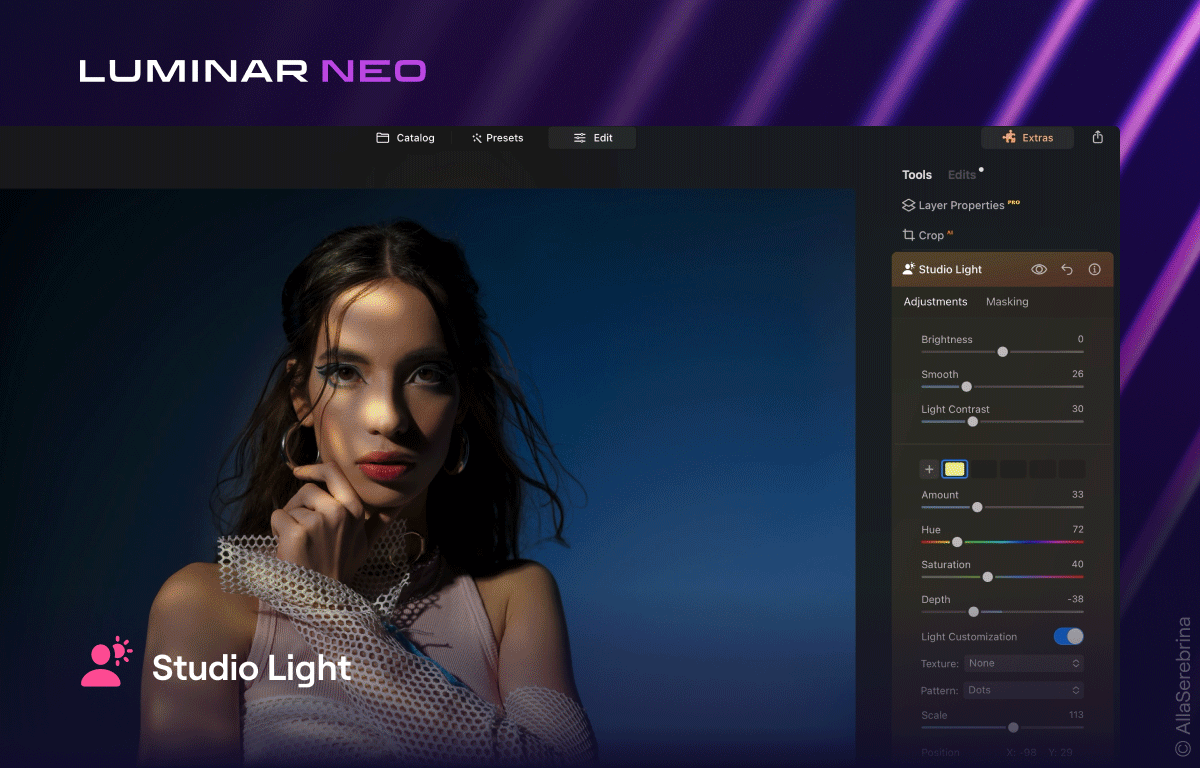
Adding creative lighting patterns to subjects brings another dimension to portrait photography.
You can use it to simulate warm sunlight as it spills through a window or the dappling of light and shadow by adding textures and patterns to your portraits.
As someone who’s experimented a lot with creative lighting techniques, I found Studio Light to give accurate and realistic results, so long as you provide it with a good portrait image in the first place.
Blur Tool (Released Aug 31, 2023)
The Blur Tool is a new feature accessible to all Luminar Neo owners via the Creative panel of tools.
It allows you to add three types of blur effects to your photos: gaussian, motion and twisted. You can also adjust the amount, angle and position of the blurring and use masking to apply it to specific areas of a photo.
I tried using the Blur Tool to make the wheels of a (static) car look like it was in motion, and the results were good.
Check out the video above for a fun way to make a product photo come to life using this new Luminar feature.
10. Output and Sharing

Sharing options are definitely limited.
Once you’ve done editing your photos, you may be wondering what next – how do you get your photos out of Luminar Neo?
The answer lies in a tiny share button located in the top right corner of Neo – clicking it reveals 4 sharing options: ‘Disk’, ‘Messages’, ‘Mail’ or ‘Share to Device’ via the companion app.
Why Skylum chose not to include all these options in a dedicated export module baffles me.
Another bizarre omission is any dedicated print module – the only way to print images from Luminar Neo is by clicking File > Print in the top menu, which exports your chosen image to your computer’s default print app.
The lack of export and print options is all rather anti-climatic. After making your photos look amazing with all the various AI tools, you’re left wondering why Skylum isn’t as excited as you to share or print them!
For professional or keen hobbyist photographers, the inability to control export settings or the print process may be a deal-breaker.
However, many photographers simply won’t care. It’s a straightforward process, and at the end of the day, you’re still able to get your photos out of Neo to store, share or print.

Selecting Print from the menu just launches your default OS print screen.
The option to ‘Share to Device’ is an odd one. You’re instructed to scan a QR code using your phone to connect the Luminar Share app to the desktop Neo software.
From here, you can ‘Send Photos to Luminar Neo’ or ‘Mirror Luminar Neo’ – the latter option lets you see any edits you make to your image in real-time.
At first, I dismissed the companion app as completely useless, but in time I realised its appeal to Instagrammers in particular as a way to share Luminar Neo creations on Instagram in fewer steps.
It’s also a handy direct way to transfer any images shot on your phone to Neo without any noticeable degradation in image quality.
11. Overall Performance of Luminar Neo

AI tools cause brief CPU spikes.
Since testing a buggy and frustratingly slow early access version for my initial (scathing) Luminar Neo review, I have to say things have improved in the performance department.
However, there are still some issues with speed, most notably when you apply presets or use any of the processor-intensive AI tools for the first time.
We were promised a much faster experience with Luminar Neo when compared to its predecessors. While I admit the AI toolset is certainly quicker than Luminar AI, there’s still room for improvement.
Clicking ‘Sky AI’, for example, involves a couple of seconds of waiting for the new sky to be added. However, any subsequent sky replacement edits happen almost instantly.
Luminar Neo’s imaging engine needs a couple of seconds to analyse the contents of your photo – when that’s complete, making various changes within the same tool is a relatively fast and smooth process.
In testing, I used Mac OS’s Activity Monitor to see what was happening under the hood of Luminar Neo, and sure enough, the AI tools caused a sharp spike in CPU usage, which quickly dissipated to normal levels.
Since the CPU spikes are so short-lived (2-4 seconds), they don’t affect the stability of any applications you may have running in the background.
However, these spikes may have been the reason for the software to occasionally crash like Lightroom and any other processor-intensive editing software.
One thing I would like to see in Luminar Neo is some kind of indication that the software is processing a task – it can be quite disconcerting to be waiting without knowing if anything is actually happening. A simple spinning wheel on the cursor would suffice.
Aside from the headline AI features, everything else functions well, with good responsiveness and smooth transitions.
There’s little to no delay when switching between the ‘Catalog’, ‘Presets’ and ‘Edit’ modules, which is something Lightroom usually struggles with.
Adding images to Luminar Neo is lightning fast, although you do need to wait a second for the image to render if you want to edit it.
Some users would prefer to have Luminar Neo GPU acceleration – rather than relying on the CPU to perform processor-intensive tasks.
However, as of the latest update, only the Noiseless AI extension runs on your computer’s GPU and will work with only macOS 11 and 12.
All in all, as long as your computer meets and preferably exceeds the minimum system requirements and you’re aware of the lack of any indication that an image is processing, using Neo is much less frustrating than it used to be.
12. Luminar Extensions

Neo can be enhanced with Extensions.
A key benefit of Luminar Neo over its previous versions is that it’s built on a modular framework using a new core engine – this means that Skylum can provide significant upgrades to the base software with extensions, a bit like 3rd party plugins do with other editing software.
Last year, Skylum began to launch various Extensions to expand the core functionality of the software.
The HDR Merge Extension allows you to create high-dynamic-range images from up to 10-bracketed images or simulate the effect by increasing the dynamic range from a single photo.
Other features include auto-alignment of multiple images for when your shots are slightly misaligned (useful for hand-held shots), and ghost-reduction when there’s a moving object in your otherwise still shot.
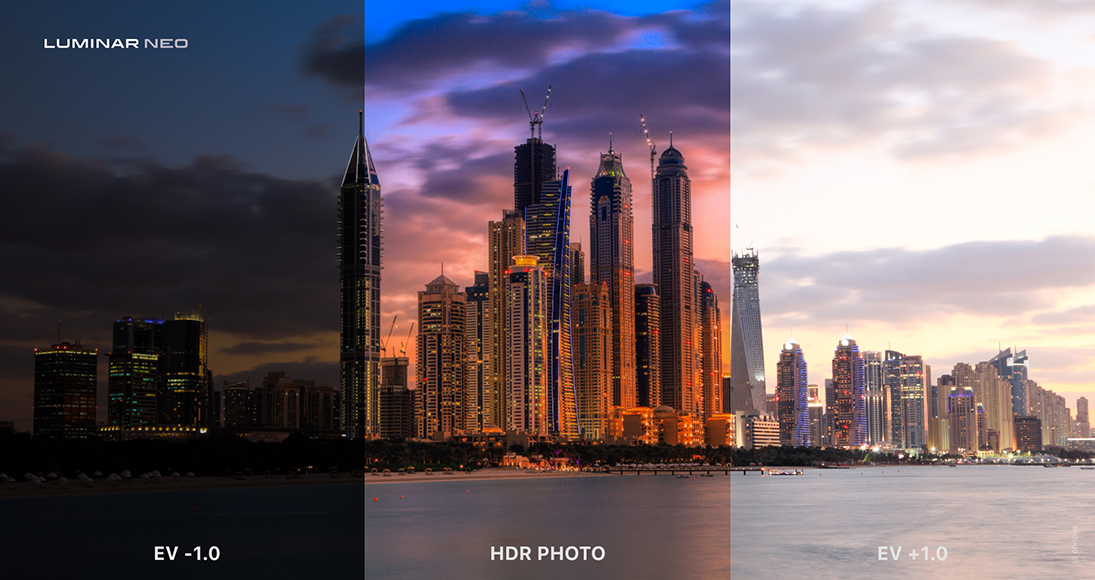
HDR can squeeze every last detail and colour from your images.
HDR photography is a popular technique for landscape, architecture, and real estate photographers in particular, or anyone who wants to bring out details in underexposed nighttime photos or fine-tune images with exposure issues.
Since the merge functionality is housed within Neo, you can still take advantage of all of Neo’s other editing tools after producing your HDR image.
HDR Merge only works as a paid extension within Luminar Neo – to activate it, you need to click on the extension button near the Luminar logo. Once purchased, it can be found in the side panel of the Catalog module.
You can find out more about the HDR Merge extension and the various ways to get it here.
Another exciting new extension is AI Background Removal which allows you to remove the background from behind the main subject of your photo and then replace it with anything you like. This is especially helpful for product photography.
Upscale AI is a great extension that helps with image resizing, allowing you to upscale a photo up to 6x and increase image resolution in a natural way. This is great if you need to digitally ‘zoom in’ on an element in a photo or prepare an image for print and maximise print quality.
Then there’s Background Removal which does exactly what you’d expect, Supersharp AI for sharpening your images, and a Focus Stacking tool, which is particularly useful for landscape and macro photography.
More recently, Magic LightAI joined the existing family of extensions.
This exciting new tool analyzes the photo and looks for any points emitting light, then lets you make them more intense, add beams and adjust the glow.
Note that Magic LightAI and all other Extensions are available in Luminar Neo for Pro Plan monthly and yearly subscribers as well as for owners of the Extensions Pack. Additionally, Extensions can now be purchased separately.
With more extensions still to be released, this is an exciting time – I’ll be gradually updating this Luminar Neo review to keep up with all the latest features.
13. Using Luminar Neo as a Plugin
For anyone already engrained in the Adobe ecosystem, using Luminar Neo as a plugin is a great way to get the best out of both software.
I use Adobe Lightroom every day to organise and edit photos and enjoy the editing process as part of my professional and personal workflow.
When there’s a specific edit that would be best performed with Luminar Neo (such as the removal of power lines), all you need to do is right-click on the image in Lightroom and select Edit In > Luminar Neo.
Then you choose TIFF, PSD or JPG as the duplicated file, keeping the original RAW or JPEG Lightroom image untouched.
This opens a ‘child’ Luminar window, where you can continue the edit using all the fancy Luminar tools.
When you’re done, the edited file is transferred back to Lightroom. Overall it’s an efficient workflow, although I do wish the transfer occurred a little quicker.
One thing to note is that you need the original file in your Lightroom catalogue to use the Edit In command – it won’t work with Lightroom Smart Previews.
Luminar Neo Review Procedure: How I Tested the Software
For the purposes of this review, I tested the latest version of Luminar Neo on a 2021 14″ MacBook Pro with 32GB of RAM.
Since many users will have lesser-powered computers, I also tested Luminar on my wife’s aging Macbook Air which has 16GB of RAM and an older Intel chip.
I have also been testing it on my wife’s new 15″ MacBook Air (M2) with 24GB RAM.
I downloaded a fresh install of the latest version of Luminar from the Skylum website so I could test it from scratch as a ‘new’ user.
Although I’ve been using Luminar Neo and all previous versions extensively, I wanted to test Luminar from the perspective of someone using it for the first time.
I recently gained access to a friend’s Dell Inspiron Intel Core i7 Windows laptop in order to test Luminar Neo for PC users.
To test Luminar Neo, I imported a selection of 150+ RAW and JPEG images taken in a variety of lighting conditions with various cameras and lenses.
I spent several hours testing each AI-powered tool, as well as the manual editing features of Luminar, to get a better idea of what the software is capable of.
I also asked professional photographer Jacqueline Portolese to test Luminar Neo and record her findings in the YouTube video above.
This was the first time Jacqueline had used Luminar, so it offers some insight into ease of use and initial impressions of the software.
Now, let’s take a closer look at the setup and key features of the Luminar photo editing software.
How Much Does Luminar Neo Cost? (Luminar Neo Price)

Luminar Neo Price
The Luminar Neo price has been rather confusing ever since Skylum introduced various ways to purchase it.
Luminar Neo is currently available in 3 Plans:
1. Explore: Subscription that includes the essential tools: $9.95/mo or $99/yr (16% saving)
2. Pro: Subscription that includes tools and Pro Extensions: $14.95/mo or $119/yr (33% saving)
3. Lifetime: Own Luminar Neo forever (outright): $149 one-time payment. You can also pay $299 to include the Extension Pack.
My recommendation:
Buy Luminar Neo on the Pro plan since you get all the amazing extensions, and if you pay for the yearly option, you save 33%, making it the best value for money out of all the 3 plans. It also lets you use Neo on 2 computers.
Tap here to see all pricing in your currency >>
(All options come with a 30-day money-back guarantee since there is currently no Luminar Neo free trial available. There’s also no student discount.)
Only the Pro plan allows you to use Neo on two computers.
There are other plans that include a Luminar X Membership, the Extensions Pack, and various bundle presets as gifts – since the offers frequently change, tap the button below to see exactly what’s available today.
Who is Luminar Neo for?
Buy Luminar Neo if:
- You want to save time editing photos – there’s no denying how useful the AI tools are in Lumianr Neo. There’s no simpler and faster way to perform certain complex edits using ai photo tools, and the one-click presets make your photos undeniably prettier.
- You don’t want to pay for an Adobe subscription – while Luminar Neo is definitely not a replacement for Lightroom or Photoshop, it does offer many of their tools and several that don’t exist on either platform.
Luminar Neo can be bought outright for the same price as a few months’ Adobe subscription, making it great value for money. It also has more AI photography related features.
- You find Photoshop too complicated – again, they’re very different programs, but Neo can help you perform complicated image edits in seconds that would take you hours in Photoshop.
- You want to have fun with your photo editing – playing around in Neo is fun. The interface encourages experimentation, and tool labeling is mostly simple and self-explanatory.
- You’re a heavy Instagram user and need a simple way to polish and share photos
Don’t Buy Luminar Neo if:
- You need powerful photo management tools – Neo is more of a photo browser than it is a photo manager. The distinct lack of keywording/tagging/sorting tools makes it a no-go for pros who require this functionality.
- You need various print options – there’s no way to print photo sheets, collages, etc. You can only control print sizes from within your computer’s default printing app.
- You need an integrated mobile editing app – while you can wirelessly transfer images to and from Luminar Neo to the smartphone app, you can’t do much else with it. It’s a far cry from the excellent Lightroom Mobile app.
- You already own Luminar AI – there’s little need to upgrade at this point unless you really need one of the aforementioned tools that the older software is lacking. See also: Luminar AI vs Luminar Neo.
- You don’t have a powerful PC or Mac – check the Luminar Neo recommended specs below. If you don’t meet them, the editing experience will be sluggish.
Alternatives to Luminar NEO
- Adobe Photoshop – a powerful vector graphics editor and image manipulator with a steep learning curve. Photoshop can replace skies and perform portrait retouching like Neo, but it’s much less user-friendly and also requires a monthly subscription.
- GIMP – a free, open-source alternative to Neo with a rather dated interface and no AI-powered tools. It’s also not suitable for batch editing or managing a photo library.
Final Words
There’s no denying that Luminar Neo has some impressive party tricks.
The entire focus of the Skylum marketing and the furore surrounding its release has been on these headline AI features, and in that, Neo completely delivers – it’s a formidable AI photo editing software.
As a ‘regular’ image editor, it offers all the tools most photographers will ever need for a manual editing experience.
Where it falls short, however, is as a one-stop-shop for all your photo management/editing needs – this is why it’s also been developed as a free plugin for Lightroom, a far superior DAM.
At first, I thought a professional photographer like me would have no need for Luminar Neo, but I was wrong. In fact, I find myself opening Neo to perform quick image edits that would normally take much longer or just simply to play around with my photos.
It’s in this experimentation that I’ve grown to enjoy using Luminar Neo – editing photos is no longer a laborious task or a means to an end.
Furthermore, for amateur photographers or those simply unaccustomed to complex post-production techniques, Luminar Neo is a silver bullet to achieving things that would otherwise be impossible.
Once you accept Luminar Neo for what it is, it’s hard to resist. It’s a simple, powerful, enjoyable and affordable software that continues to improve.

Powerful AI editing tools improve photos in less time. Affordable one-time price and expandable features.
Frequently Asked Questions About Luminar
Is Luminar Neo better than Luminar AI?
Yes, Luminar Neo is much better than Luminar AI since it has the latest and greatest photo editing features provided by Skylum. Neo also supports Extensions which make the core software even more powerful. Neo is built on a different framework to AI which means it can be updated more easily and more regularly, which is better for the user.
Does Luminar Neo replace Luminar AI?
Although Skylum has not said this officially, the likelihood is that Luminar Neo will replace Luminar AI in due course. Users purchasing Luminar for the first time are recommended to buy Luminar Neo.
Is Luminar Neo better than Lightroom?
For certain artificial intelligence-related tasks, yes, Luminar Neo is better than Lightroom – it can perform complex editing tasks more quickly and more simply. It also offers more presets that adjust with AI than Lightroom currently does. However, Lightroom’s photo management, printing options, data management and mobile app are superior to Luminar Neo.
Is Luminar Neo better than Photoshop?
Photoshop is the more powerful layer-based image manipulation software, but Luminar Neo can perform similar tasks much more quickly and easily. For beginners or inexperienced image editors, Luminar Neo is better than Photoshop, although there are some editing actions it cannot perform.
Is Luminar Neo a one-time purchase?
Yes, Luminar Neo is a one-time purchase, meaning you don’t need to pay a monthly subscription to be able to use it. However, there is also the option of a subscription plan, which provides additional benefits such as free lifetime upgrades, extensions and more.
Does Luminar Neo work on iPad?
No, Luminar Neo only works on PC and Mac. However, its developer Skylum Software released an iOS app that offers nearly the same features.
Known as Imgmi, this app helps you post-process photos by allowing you to remove or replace unwanted elements, such as power lines and overcast skies. Needless to say, it’s easy to improve image exposure and colour saturation simply by adjusting the app’s basic editing controls.
Is there a Luminar Neo Trial?
No, there is no trial from Luminar Neo, but there is a 30-day money-back guarantee if you’re not satisfied with the software.
What are the System Requirements?
Mac:
- MacBook, MacBook Air, MacBook Pro, iMac, iMac Pro, Mac Pro, Mac mini, early 2010 or newer
- CPU Intel® Core™ i5 or better
- Memory 8 GB RAM or more (16+ GB RAM is recommended)
- macOS 10.14.6 or higher. IMPORTANT: macOS 10.13 is not supported.
- Hard disk 10 GB free space; SSD for best performance
- Display 1280×768 size or better
- Now compatible with macOS Sonoma
Windows:
- Windows-based hardware PC with mouse or similar input device
- CPU Intel® Core™ i5 or better, AMD Ryzen™ 5 or better
- Open GL 3.3 or later compatible Graphics Cards
- Memory 8 GB RAM or more (16+ GB RAM is recommended)
- Operating System Windows 10 version 1909 or higher (only 64-bit OS).
- Hard disk 10 GB free space; SSD for best performance
- Display 1280×768 size or better
What are the Supported Languages?
- English
- German
- Spanish
- French
- Portuguese
- Italian
- Chinese Simplified
- Chinese Traditional
- Korean
- Japanese
- Dutch
More info here.
What is the latest version of Luminar Neo?
The latest version of Luminar Neo is v1.14.1. It was released on October 12, 2023.
Is there a Luminar Neo User Guide PDF?
Yes, you can download a Luminar Neo PDF user guide from this link.
What is the difference between the Luminar Explore and Pro plans?
In both plans, you get access to the Luminar Neo photo editor app, but with the Pro plan, you also get:
- Immediate access to all existing pro-level Extensions and future access to any new Extensions as soon as they are released: AI-based tools for sharpening, upscaling, noise reduction, focus stacking, merging HDR images, background removal, light manipulation, and more.
- The ability to use Luminar Neo on two devices instead of one
- A bigger reduction (10% instead of 5%) on Marketplace items (Skies, Presets, LUTs, Overlays, etc.)
Resources & References








